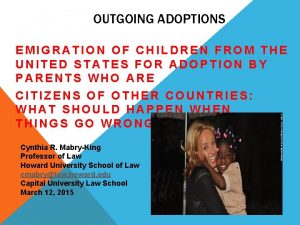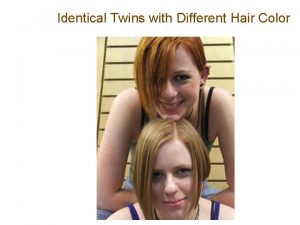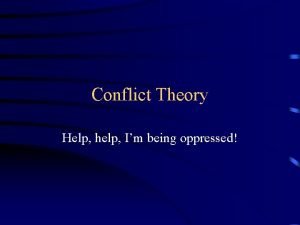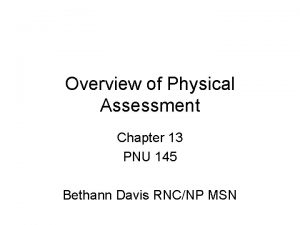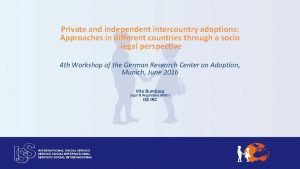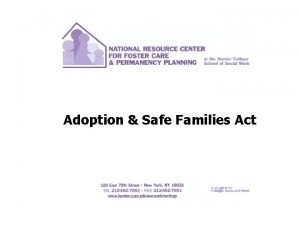Studying Twins and Adoptions Can Help Assess the


















- Slides: 18

Studying Twins and Adoptions Can Help Assess the Importance of Genes and Environment Genetics

§ Twins and adoptions provide natural experiments for separating the effects of genes and environmental factors in determining differences in traits. § These two techniques have been widely used in genetic studies.

Types of Twins § Twins are of two types: Ø dizygotic (nonidentical) twins arise when two separate eggs are fertilized by two different sperm, producing genetically distinct zygotes; Ø Monozygotic (identical) twins result when a single egg, fertilized by a single sperm, splits early in development into two separate embryos. § Because monozygotic twins result from a single egg and sperm (a single, “mono, ” zygote), they’re genetically identical (except for rare somatic mutations), having 100% of their genes in common

§ Dizygotic twins, on the other hand, have on average only 50% of their genes in common, which is the same percentage that any pair of siblings has in common. § Like other siblings, dizygotic twins may be of the same sex or of different sexes. § The only difference between dizygotic twins and other siblings is that dizygotic twins are the same age and shared the same uterine environment. § Dizygotic twinning often runs in families and the tendancy to produce dizygotic twins is influenced by heredity, but there appears to be little genetic tendency for producing monozygotic twins.


Concordance in Twins § Comparisons of dizygotic and monozygotic twins can be used to assess the importance of genetic and environmental factors in producing differences in a characteristic. § This assessment is often made by calculating the concordance for a trait. § If both members of a twin pair have a trait, the twins are said to be concordant; if only one member of the pair has the trait, the twins are said to be discordant. § Concordance is the percentage of twin pairs that are concordant for a trait.

§ Because identical twins have 100% of their genes in common and dizygotic twins have on average only 50% in common, genetically influenced traits should exhibit higher concordance in monozygotic twins. § For instance, when one member of a monozygotic twin pair has epilepsy, the other twin of the pair has epilepsy about 59% of the time; so the monozygotic concordance for epilepsy is 59%. § However, when a dizygotic twin has epilepsy, the other twin has epilepsy only 19% of the time (19% dizygotic concordance). § The higher concordance in the monozygotic twins suggests that genes influence epilepsy, a finding supported by the results of other family studies of this disease.

§ The hallmark of a genetic influence on a particular trait is higher concordance in monozygotic twins compared with concordance in dizygotic twins. § High concordance in monozygotic twins by itself does not signal a genetic influence. !! § Twins normally share the same environment—they are raised in the same home, have the same friends, attend the same school— and so high concordance may be due to common genes or to common environment. § If the high concordance is due to environmental factors, then dizygotic twins, who also share the same environment, should have just as high a concordance as that of monozygotic twins.

§ When genes influence the trait, however, monozygotic twin pairs should exhibit higher concordance than that of dizygotic twin pairs, because monozygotic twins have a greater percentage of genes in common. § It is important to note that any discordance among monozygotic twins is usually due to environmental factors, because monozygotic twins are genetically identical. § The use of twins in genetic research rests on the important assumption that: Ø when concordance for monozygotic twins is greater than that for dizygotic twins, it is because monozygotic twins are more similar in their genes and not because they have experienced a more similar environment.

§ The degree of environmental similarity between monozygotic twins and dizygotic twins is assumed to be the same. § This assumption may not always be correct, particularly for human behaviors. !!! § Because they look alike, identical twins may be treated more similarly by parents, teachers, and peers than are non-identical twins. § Evidence of this similar treatment is seen in the past tendency of parents to dress identical twins alike. § In spite of this potential complication, twin studies have played a pivotal role in the study of human genetics.

Adoption Studies § Another technique used by geneticists to analyze human inheritance is the study of adopted people. § This approach is one of the most powerful for distinguishing the effects of genes and environment on characteristics. § For a variety of reasons, many children each year are separated from their biological parents soon after birth and adopted by adults with whom they have no genetic relationship. § These adopted persons have no more genes in common with their adoptive parents than do two randomly chosen persons; however, they do share an environment with their adoptive parents.

§ In contrast, the adopted persons have 50% of their genes in common with each of their biological parents but do not share the same environment with them. § If adopted persons and their adoptive parents show similarities in a characteristic, these similarities can be attributed to environmental factors. § If, on the other hand, adopted persons and their biological parents show similarities, these similarities are likely to be due to genetic factors. § Comparisons of adopted persons with their adoptive parents and with their biological parents can therefore help to define the roles of genetic and environmental factors in the determination of human variation.

Genetic Counseling and Genetic Testing Provide Information to Those Concerned about Genetic Diseases and Traits

Genetic Counseling § Genetic counseling is a field that provides information to patients and others who are concerned about hereditary conditions. § It is an educational process that helps patients and family members deal with many aspects of a genetic condition including a diagnosis, information about symptoms and treatment, and information about the mode of inheritance. § Genetic counseling also helps a patient and the family cope with the psychological and physical stress that may be associated with the disorder. § All of these considerations cannot be handled by a single person; so most genetic counseling is done by a team that can include counselors, physicians, medical geneticists, and laboratory personnel.

Table lists some common reasons for seeking genetic counseling:


References § Benjamin A. Pierce, 2010. Genetics: A Conceptual Approach, 4 th Edition. W. H. Freeman.

The End
 Outgoing adoptions
Outgoing adoptions Culture or way of living station 1
Culture or way of living station 1 Education through self help is our motto
Education through self help is our motto Fraternal twins with different hair color
Fraternal twins with different hair color Freesurfer troubleshooting
Freesurfer troubleshooting I m being oppressed
I m being oppressed Help help chapter 1
Help help chapter 1 Spagetti poem
Spagetti poem Help us help you
Help us help you How to assess alert and oriented
How to assess alert and oriented How to assess alert and oriented
How to assess alert and oriented Secure assess evolve
Secure assess evolve City & guilds evolve
City & guilds evolve The apices of the lungs
The apices of the lungs Hr planning process
Hr planning process Tactile fermitus
Tactile fermitus What is the definition of time critical risk management
What is the definition of time critical risk management Nutrition assessment
Nutrition assessment Human resource management in retailing
Human resource management in retailing
